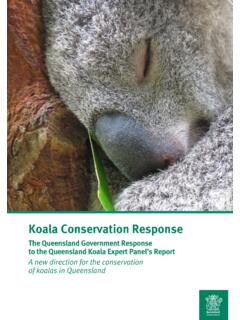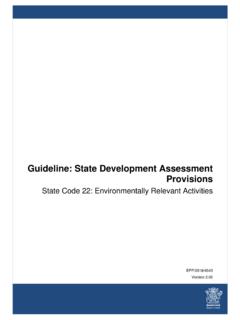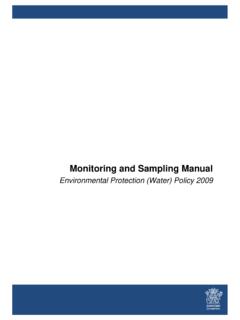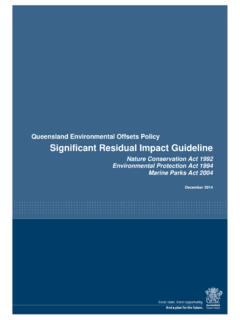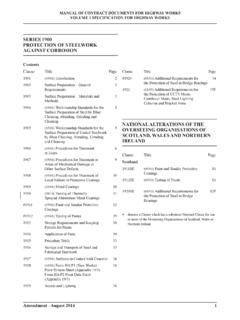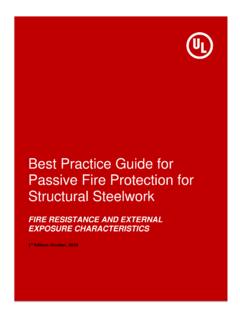Transcription of Motor vehicle worshop code of practice EM1304
1 General environmental duty Code of practice for Motor vehicle workshop operations Motor vehicle workshop code of practice 2 Table of contents 1. introduction .. 3 2. Objective of the code .. 3 3. Scope of the code .. 3 4. Commencement date .. 3 5. Authorisation and amendment of the code .. 4 6. Acknowledgement .. 4 7. Using the code of practice .. 4 Performance outcomes .. 4 Control measures .. 4 Environmental management plan .. 4 Performance outcome 1: .. 6 Performance outcome 2: .. 8 Performance outcome 3: .. 9 Performance outcome 4: .. 10 Appendix 1: General obligations under the Environmental Protection Act 1994 .. 12 General environmental duty .. 12 Duty to notify .. 12 Relevant offences under the Environmental Protection Act 1994 .. 13 Relevant offences under the Waste Reduction and Recycling Act 2011.
2 13 Appendix 2: Other resources .. 14 Green stamp .. 14 Pollution solutions .. 14 EcoBiz .. 14 Toolbox .. 14 Motor vehicle workshop code of practice 3 1. introduction This environmental code of practice has been prepared to provide guidance to operators to help them comply with the Environmental Protection Act 1994 by meeting their general environmental duty. The code also outlines the environmental best management practices of leaders in the industry. Under Section 319 of the Environmental Protection Act 1994, all persons in Queensland must fulfil their general environmental duty . This is defined as follows: A person must not carry out an activity that causes, or is likely to cause, environmental harm unless the person takes all reasonable and practicable measures to prevent or minimise the harm.
3 See Appendix 1. This document describes Motor vehicle workshop operations, the potential impacts on the environment, and what actions a Motor vehicle workshop operator can take to prevent and or minimise those risks. Although this environmental code of practice is a voluntarily adopted standard for the Motor vehicle workshop industry in Queensland, complying with this code provides the operator with a defence against a charge of unlawfully causing environmental harm and several other charges to the extent the code is relevant. 2. Objective of the code The environmental code of practice aims to: describe environmental issues and challenges confronting Motor vehicle workshop operations in Queensland assist operators to better consider the environment with which they interact provide advice to decision-making authorities to enable them to make consistent decisions in respect to Motor vehicle workshop operations suggest practical measures to minimise environmental and social impacts allow industry to establish a benchmark environmental performance demonstrate to the community the environmental compatibility of the Motor vehicle workshop industry.
4 3. Scope of the code This environmental code of practice addresses environmental aspects of Motor vehicle workshop operations. It does not cover environmental issues to do with planning or construction, and does not cover aspects covered by other legislation such as work health and safety. The code does not restate any requirements of the Environmental Protection Act 1994, nor does it override or replace federal, state or local government legislation, regulation, plans or policies. This environmental code of practice applies to fixed site Motor vehicle workshops operated by a commercial (whether on a commercial basis or in the course of carrying on a commercial enterprise) or government entity. Motor vehicle workshop operations include operating a workshop involving any of the following relating to Motor vehicles repairing and maintaining mechanical components, engine cooling radiators or body panels spray-painting body panels detailing or washing.
5 4. Commencement date This environmental code of practice commenced on 27 June 2014 and has effect for seven years. To continue to have effect the code of practice must be reviewed and approved by the Minister by 26 June 2021. Industry members are encouraged to provide feedback and to report new initiatives to their associations, so the codes can evolve through each review. Motor vehicle workshop code of practice 4 5. Authorisation and amendment of the code Under section 318E(1) of the Environmental Protection Act 1994, the Minister may, by gazette notice, make codes of practice stating ways of achieving compliance with the general environmental duty for an activity that causes, or is likely to cause, environmental harm. Once the code has been gazetted it may also be amended by gazette notice. 6. Acknowledgement The department acknowledges the work of the Motor Traders Association of Queensland and the Local Government Association of Queensland in the preparation of this code of practice .
6 7. Using the code of practice There are a number of environmental risks associated with Motor vehicle workshops. These include, but are not limited to: the release of harmful airborne contaminants and odours from fuel, paint , solvents and other chemicals that may cause harm to people s health and wellbeing contaminated stormwater runoff entering waterways and land noise causing a nuisance to nearby sensitive places waste that may become litter or contaminant the environment. The code of practice : gives practical guidance on how environment best management practice can be achieved in the Motor vehicle workshop sector should be followed unless there is an alternative course of action that achieves the same or a better environmental objective. Performance outcomes Performance outcomes are the end result that the operator needs to achieve to meet the general environmental duty described under the Environmental Protection Act 1994.
7 There are 4 performance outcomes in this code of practice : there is no discharge to land or water of contaminants that may harm the environment or create a nuisance from the operation of the activity there is no discharge to air of contaminants that may harm the environment or create a nuisance from the operation of the activity noise nuisance is prevented or minimised at noise sensitive places waste production and disposal must be minimised and waste must be managed so it does not harm the environment or create a nuisance from the operation of the activity. There are a number of suggested control measures to achieve the performance outcome. Control measures Control measures are suggested examples which have been provided to help you to achieve the performance outcome. In some cases, a number of compliance control measures may be listed for one process.
8 In these cases, you are advised to aim for the control measure or combination of control measures that is most likely to achieve the performance outcome for that process. Alternatively, you may be able to meet a performance outcome in a manner that is not listed in this code of practice . If you choose to use your own control measure, you won t get the benefit of the code. Environmental management plan An environmental management plan identifies environmental risks caused by the operation and puts activities in place to manage these risks before they result in environmental harm. The performance outcomes and examples for meeting the environmental objectives listed in this document will form a solid basis for creating your management plan. Motor vehicle workshop code of practice 5 By developing and following an environmental management plan your business can demonstrate that all reasonable care is being taken to avoid causing environmental harm.
9 Your business will be able to use this reasonable care, or due diligence, as a defence for compliance purposes. Developing and following an environmental management plan should ensure: all potential environmental risks from the activity are identified and control measures are in place to prevent or minimise the potential for environmental harm contingency measures are in place to avoid environmental harm in the event of unforeseen circumstances or natural disasters ( flood) staff are trained and aware of their requirements of the Environmental Protection Act 1994 reviews of environmental performance is undertaken periodically records monitoring, incidents and complaints are kept. Motor vehicle workshop code of practice 6 Performance outcome 1: There is no discharge to land or water of contaminants that may harm the environment or create a nuisance from the operation of the activity.
10 Releases to land and water Releases to land and water can be caused by inappropriate storage or use of: disinfectants fuels oils detergents poisons cleaning solvents thinners alkaline or acidic solutions Potential risks and impacts Contaminants can enter the waterways or stormwater drains destroying aquatic life. This can be caused by spills of chemicals and other liquids. Chemical spills and leaks can runoff to land and cause soil contamination. Suggested control measures Keep chemicals and other liquids such as fuels, solvents, oils, batteries and coolants within a secondary containment system that is impervious to the materials stored within it, and must be managed to prevent the release of contaminants to waters or land. Secondary containment may be fixed bunding, self bunding pallets or double skinned containers.
